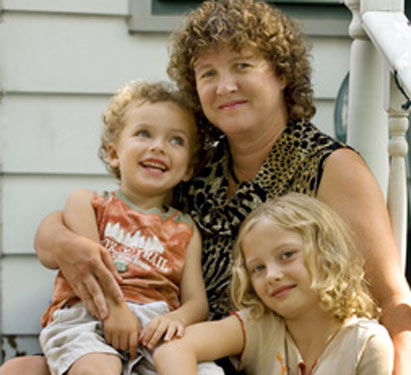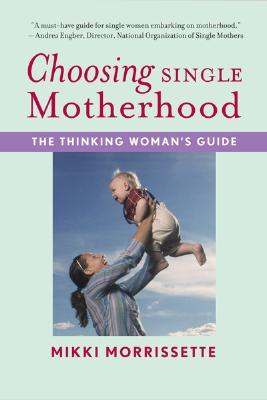If you’re looking for a comprehensive guide that covers all the “must-knows” of choosing single motherhood, then get ready, because Choosing Single Motherhood: The Thinking Woman’s Guide (2008) by Mikki Morrissette is for you. The book details how to really decide whether the single parent lifestyle is really something that you want, how to go through the process as successfully as possible, and how to talk to your kids once they’re old enough to ask questions about all this.

The book is written by Mikki Morrissette, and she is a self-proclaimed “Choice Mother”. This means that she’s a kind of mom who actively elects to have or adopt children in the absence of a life partner and chooses to raise them. The book features the latest research and educated opinions from child and family therapists about the topic of choosing single motherhood. Morrissette is also a seasoned journalist, so her career lent itself perfectly to investigating single motherhood for others who are deciding whether to embark upon the journey themselves or not.
Choosing Single Motherhood tackles all the most common questions and concerns that women may have about the decision they’re about to make, including affordability, handling stress, and when in life is the best time to become a single mother. The author explores hosts of other issues in the book as well – these are just the tip of the iceberg.
What’s in the Book

The arrangement of Choosing Single Motherhood is truly unique. It is divided into sections made up of chapters called “stages” of a woman’s experience as she decides to become a single mother and embarks upon this so called adventure. The first stage is filled with chapters devoted to solving internal conflicts before deciding to be a single mother. The woman, according to Morrissette, must decide whether she can handle – truly handle – the responsibility before she makes the commitment. Financially, emotionally, spiritually… a child will affect every aspect of the single woman’s life, so taking an honest personal inventory is pivotal to success as a single mother down the road.
The next chapter encourages women to “grieve the childhood dream” – to let go of the infantile fantasies of the perfect cookie-cutter life. Life is not perfect, and sometimes a supportive spouse is not in the picture too. This does not mean a woman cannot raise a child on her own, but letting go of that fantasy and embracing reality is critical to accomplish before bringing a child into a home.
There is also the issue of community acceptance, a serious social problem that the author explores in-depth in the fourth chapter of the book. Morrissette details how to cope with people viewing the single mom as “selfish” for choosing to raise a child alone, and it also offers ways in which the single mother can help her child deal with the criticism and spin it into a positive learning experience that will last for a lifetime.
The second stage of the book moves past internal conflict of the mother and into the internal conflict that may be experienced by the child. It helps women decide whether they think the lifestyle itself is fair to the child, a moral dilemma only they can – and must – answer for themselves before they take a child into their lives.
The third stage is devoted to choosing the right method for getting the child into the home. Is pregnancy the right option? What should the single mother know about sperm donors before she begins? What are the ins and outs of the adoption process? Once the method is selected, the chapters in this stage help women with the ramifications of the choice they’ve made.
Then, the fourth stage tackles the issues surrounding day-to-day parenting. This includes disciplining a child alone, without a “daddy” figure in the picture, answering questions about daddy, and helping the child as they learn how to deal with issues concerning their self-identification. The idea here is to raise a well-balanced child – something that can be accomplished regardless of lifestyle!
Finally, the fifth stage deals with the “legacy of choice” – a social commentary that touches on politics and policy surrounding single parenthood. It discusses court decisions, gay and lesbian issues, insurance problems, and more. It also sheds light on the social development of kids who have single moms, as well as how they will grow into productive adults in our society.
Real Reviews, Real Women
The women who purchased the book gave real, non-incentivized feedback on Amazon.com – and they had a lot to say about this amazing resource for single moms who consider themselves to be Choice Moms. First, as one reviewer who’d read the book pointed out, the author herself is a Choice Mom of two; a woman who conceived her children as a result of donor insemination from someone that she knew.
The woman also appreciated that the author took her own personal informed background and ran with it throughout the chapters of this text, comparing her personal life experience with all of the very latest professional literature. When she did this, it produced a smart book with only the most highly educated advice on everything from finance to community reactions, as well as how kids can grow up successfully without a male figure in their lives.
Daily stressors are covered as well in the book. Knowing how to deal with these things before bringing children into the home and raising them alone is another important consideration the author details in the book, says another woman who loved it and left a review. She thought that the section including interviews from teenagers and young adults raised by Choice Moms was refreshing. It helped give her comfort knowing that children can turn out well-adjusted after growing up in this lifestyle.
